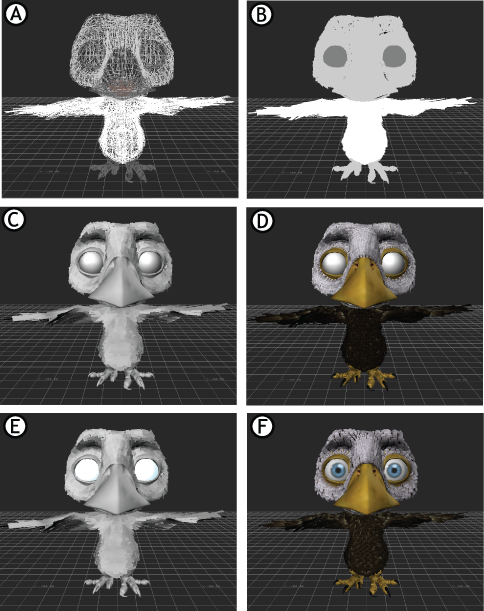The Display menu contains options that let you define which assets to display in the Viewer window and how to display them.
The Normal Display menu option sets the current camera view to Normal Display mode, which displays all assets. Normal is the default viewing mode.
The X-Ray Display menu option sets the current camera view to X-Ray mode, which displays the skeleton of a model, Nulls, and elements. In this mode, you can select and edit skeletons normally hidden by models, but you cannot select models.
The Modes Only Display menu option sets the current camera view to Models Only mode, which displays models only and hides all Nulls, lights, cameras, and other elements.
The Hide Unselected Display menu option hides elements and models that are not selected in the scene.
The Show Unselected Display menu option displays elements and models that are not selected in the scene.
The Models Display menu option contains global shading options that apply to the entire scene.

Models Display options A. Wireframe B. Flat C. Lighted D. Shaded E. Textured F. Shaded & Textured
The Models Display menu options are:
| Display option | Description |
|---|---|
| Wireframe | Displays selected objects as wireframe. |
| Flat | Displays selected objects using a constant color. This option ignores light sources in a scene, and overrides any custom shading, textures, and materials applied using the Shader settings. See Shader basics. |
| Lighted | Displays selected objects using their custom shaders created in the Shader settings. Textures do not display. |
| Textures | Displays selected objects with their applied textures. This option is available only when the Lighted option is selected, in which case Use Textures is active by default. See Textures. |
| Shaders | Displays selected objects using the default shader. This option is available only when the Lighted option is selected, in which case Use Shaders is active by default. |
| Textures + Shaders | Displays selected objects with both the default shader and their applied textures. |
The Models Visibility Display menu option hides or displays selected assets in the Viewer window. For example, when Skeleton is disabled, all skeletons are hidden in the Viewer window.
The Visibility menu lets you hide or show Nulls, Markers, Skeletons, Lights, Cameras, Devices, 3DPath, and Models.
The Stereo Display menu option contains camera views that apply to the entire scene.
The Stereo Display menu includes the following stereo views:
| Option | Description |
|---|---|
| Center Eye | Look through the center stereo camera. This is the default option |
| Left Eye | Look through the left stereo camera. |
| Right Eye | Look through the right stereo camera. |
| Active | Use your graphics card for stereo viewing. If you are using the NVidia Quadro line graphics cards, and you have turned on stereo mode, then the Active menu item becomes live. The CRT monitor uses the page flipping method of stereo imaging. The settings that you have chosen for your stereo mode in your graphics card are respected. For example, the DIN connector sends signal to your 3D glasses. |
| Horizontal Interlace | This viewing mode interlaces one row of pixels from the left camera with one row of pixels from the right camera and so forth. You obtain half the vertical resolution through this mode. Select this mode for polarized LCD monitors. |
| Checkerboard | This viewing mode alternates between one pixel from the left camera with one pixel from the right camera, forming a checkerboard pattern. You obtain half the vertical resolution and half the horizontal resolution through this mode. Select this mode for Samsung DLP 3D displays. |
| Anaglyph | MotionBuilder supports the red or cyan anaglyph mode. MotionBuilder composites the color output from the left camera with the color output from the right camera. |
| Luminance Anaglyph | The Luminance Anaglyph mode is similar to the Anaglyph mode, but the color output from the left and right cameras are first converted to grayscale, before being composited on top of each other. |
| Freeview (Parallel) | Select this mode to see the left and right camera output side by side in the same window. |
| Freeview (Crossed) | This mode is similar to Freeview (Parallel), but the left camera output is displayed on the right while the right camera output is displayed on the left. |
See Stereo cameras.
The Head-up Display (HUD) menu option enables you to display frame rate, memory usage, time code, and safe area.
The HUD Display Rate displays MotionBuilder operational statistics in the top-left corner of the Viewer window. Because MotionBuilder is a multi-thread application that uses a dual-buffer system, it evaluates the upcoming frame ahead of rendering it.
You can change the color of the statistics display. See the HUD preference settings in the Viewer preferences.
The HUD Display Memory Usage displays the amount of free memory and of free recording memory. These appear in the top-right corner of the Viewer window.
The HUD Display Safe Area activates Display Safe Area to show the safe display area for all cameras.

Viewer window displays Safe Area
The safe display area contains two different safe guides: the safe title guide (yellow) indicating the area in which titles should be placed, and a safe action guide (red) indicating the recommended area in which motion and animation should take place.
If you do not observe these areas, titles and animation may be cropped when transferred to video.
You can choose between a square safe area and a round safe area in the Camera settings.
The HUD Display ViewCube enables you to either display or hide the ViewCube.
The HUD Display SteeringWheel enables you to either display or hide the SteeringWheels.